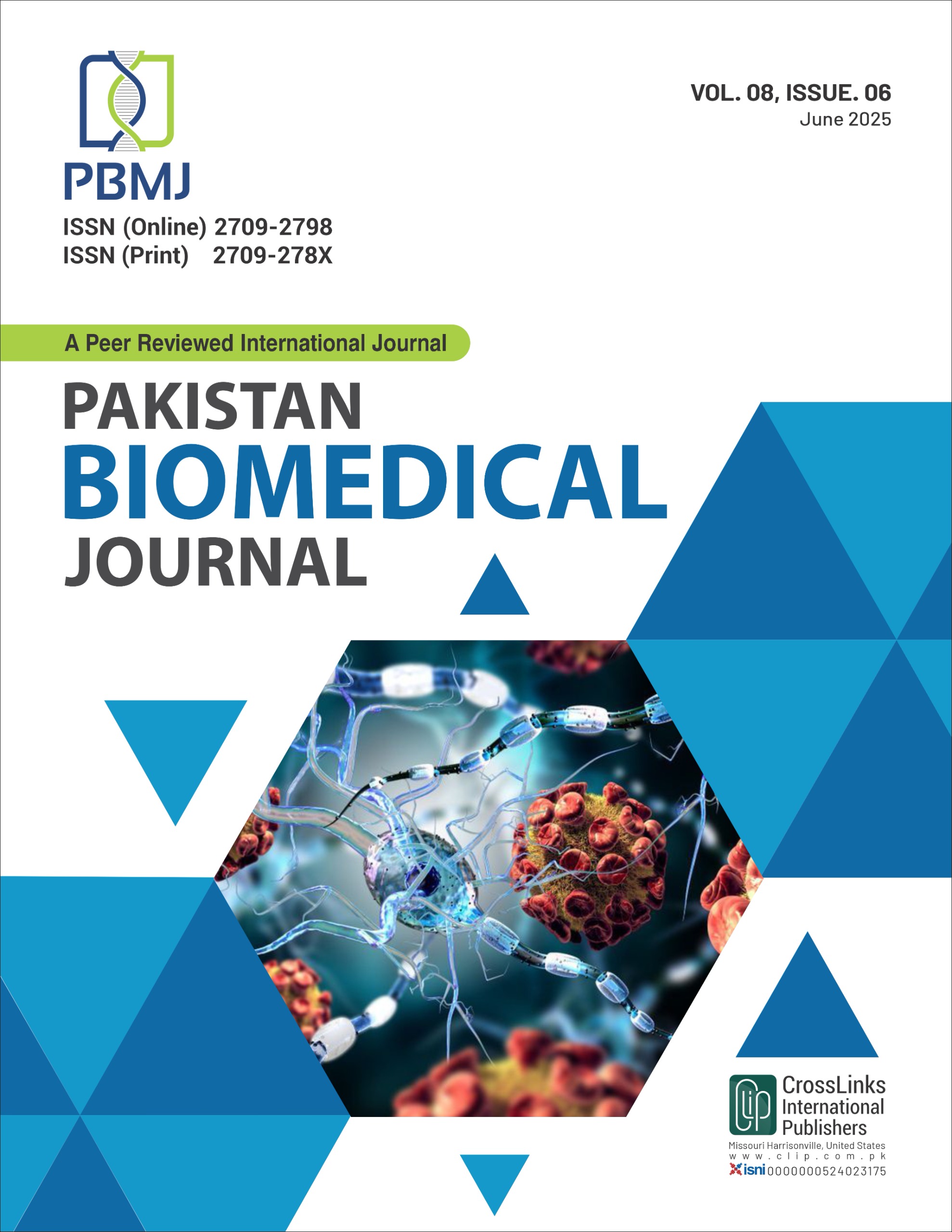Prevalence of Urinary Incontinence among Middle Aged Women and Its Association with Quality of Life
Urinary Incontinence among Women
DOI:
https://doi.org/10.54393/pbmj.v8i6.1259Keywords:
Urinary Incontinence, Middle-Aged Women, Quality of Life, Prevalence, Mental HealthAbstract
Existing literature had shown a significant rise in the prevalence of urinary incontinence among female. This increasing trend in urinary incontinence had been associated with a noticeable decline in quality of life. Objective: To evaluate the prevalence of urinary incontinence in middle aged women to find the association between urinary incontinence and quality of life of middle aged women. Methods: This observational cross-sectional analytical study was conducted in a six-month study duration in Lahore. Female patients aged 35 to 65 years were selected. Outcome measures of this study were measuring urinary incontinence and quality of life. Data were collected from Sir Ganga Ram Hospital. Data were gathered by using ICIQ-SF and SF12. Data were analyzed by using SPSS version 27.0`1. Results: This observational study enrolled middle-aged women aged 35 to 65 years. The majority (53%) were housewives, while 46% were employed. Regarding socioeconomic status, 53% reported financial stability, whereas 79% indicated economic instability a discrepancy suggesting possible reporting error. Marital status distribution showed that 59% were married, 12% unmarried, and 27% widowed. In terms of Quality of Life (QoL), 19% of participants reported poor physical health, 62% fair, and 17% good physical health. Conclusions: Most middle-aged women in this study experienced urinary incontinence, with greater severity linked to poorer physical and mental health, especially among housewives.
References
Minassian VA, Bazi T, Stewart WF. Clinical epidemiological insights into urinary incontinence. International Urogynecology Journal. 2017 May; 28: 687-96. doi: 10.1007/s00192-017-3314-7. DOI: https://doi.org/10.1007/s00192-017-3314-7
Wyndaele M and Hashim H. Pathophysiology of urinary incontinence. Surgery (Oxford). 2017 Jun; 35(6): 287-92. doi: 10.1016/j.mpsur.2017.03.002. DOI: https://doi.org/10.1016/j.mpsur.2017.03.002
Islam RM, Bell RJ, Hossain MB, Davis SR. Types of urinary incontinence in Bangladeshi women at midlife: Prevalence and risk factors. Maturitas. 2018 Oct; 116: 18-23. doi: 10.1016/j.maturitas.2018.07.012. DOI: https://doi.org/10.1016/j.maturitas.2018.07.012
Milsom I and Gyhagen M. The prevalence of urinary incontinence. Climacteric. 2019 May; 22(3): 217-22. doi: 10.1080/13697137.2018.1543263. DOI: https://doi.org/10.1080/13697137.2018.1543263
Bardsley A. An overview of urinary incontinence. British Journal of Nursing. 2016 Oct; 25(18): S14-21. doi: 10.12968/bjon.2016.25.18.S14. DOI: https://doi.org/10.12968/bjon.2016.25.18.S14
Cervigni M and Gambacciani M. Female urinary stress incontinence. Climacteric. 2015 Oct; 18(sup1): 30-6. doi: 10.3109/13697137.2015.1090859. DOI: https://doi.org/10.3109/13697137.2015.1090859
Aoki Y, Brown HW, Brubaker L, Cornu JN, Daly JO, Cartwright R. Urinary incontinence in women. Nature Reviews Disease Primers. 2017 Jul; 3(1): 1-20. doi: 10.1038/nrdp.2017.42. DOI: https://doi.org/10.1038/nrdp.2017.42
Dai S, Chen H, Luo T. Prevalence and factors of urinary incontinence among postpartum: systematic review and meta-analysis. BioMed Central Pregnancy and Childbirth. 2023 Oct; 23(1): 761. doi: 10.1186/s12884-023-06059-6. DOI: https://doi.org/10.1186/s12884-023-06059-6
Yağmur Y and Gül S. Urinary incontinence in women aged 40 and older: Its prevalence, risk factors, and effect on quality of life. Nigerian Journal of Clinical Practice. 2021 Feb; 24(2): 186-92. doi: 10.4103/njcp.njcp_626_18. DOI: https://doi.org/10.4103/njcp.njcp_626_18
Mazur-Bialy AI, Kołomańska-Bogucka D, Nowakowski C, Tim S. Urinary incontinence in women: modern methods of physiotherapy as a support for surgical treatment or independent therapy. Journal of Clinical Medicine. 2020 Apr; 9(4): 1211. doi: 10.3390/jcm9041211. DOI: https://doi.org/10.3390/jcm9041211
Khandelwal C and Kistler C. Diagnosis of urinary incontinence. American Family Physician. 2013 Apr; 87(8): 543-50.
Bernards AT, Berghmans BC, Slieker-ten Hove MC, Staal JB, de Bie RA, Hendriks EJ. Dutch gurinary incontinence delines for physiotherapy in patients with stress urinary incontinence: an update. International Urogynecology Journal. 2014 Feb; 25: 171-9. doi: 10.1007/s00192-013-2219-3. DOI: https://doi.org/10.1007/s00192-013-2219-3
Trowbridge ER and Hoover EF. Evaluation and treatment of urinary incontinence in women. Gastroenterology Clinics. 2022 Mar; 51(1): 157-75. doi: 10.1016/j.gtc.2021.10.010. DOI: https://doi.org/10.1016/j.gtc.2021.10.010
Shang X, Fu Y, Jin X, Wang C, Wang P, Guo P et al. Association of overweight, obesity and risk of urinary incontinence in middle-aged and older women: a meta epidemiology study. Frontiers in Endocrinology. 2023 Oct; 14: 1220551. doi: 10.3389/fendo.2023.1220551. DOI: https://doi.org/10.3389/fendo.2023.1220551
Chow PM, Chuang YC, Hsu KC, Shen YC, Liu SP. Impact of female stress urinary incontinence on quality of life, mental health, work limitation, and healthcare seeking in China, Taiwan, and South Korea (LUTS Asia): results from a cross-sectional, population-based study. International Journal of Women's Health. 2022 Dec: 1871-80. doi: 10.2147/IJWH.S383651. DOI: https://doi.org/10.2147/IJWH.S383651
Veronese N, Smith L, Pizzol D, Soysal P, Maggi S, Ilie PC et al. Urinary incontinence and quality of life: a longitudinal analysis from the English Longitudinal Study of Ageing. Maturitas. 2022 Jun; 160: 11-5. doi: 10.1016/j.maturitas.2022.01.010. DOI: https://doi.org/10.1016/j.maturitas.2022.01.010
Najafi Z, Morowatisharifabad MA, Jambarsang S, Rezaeipandari H, Hemayati R. Urinary incontinence and related quality of life among elderly women in Tabas, South Khorasan, Iran. BioMed Central Urology. 2022 Dec; 22(1): 214. doi: 10.1186/s12894-022-01171-9. DOI: https://doi.org/10.1186/s12894-022-01171-9
Pizzol D, Demurtas J, Celotto S, Maggi S, Smith L, Angiolelli G et al. Urinary incontinence and quality of life: a systematic review and meta-analysis. Aging Clinical and Experimental Research. 2021 Jan; 33: 25-35. doi: 10.1007/s40520-020-01712-y. DOI: https://doi.org/10.1007/s40520-020-01712-y
Hassan S, Malik KK, Khursheed MA, Seikh AH, Ali A, Siddiqui AA. Frequency of Different Types of Urinary Incontinence and Their impact on Quality of Life of Pakistani Women: Different Types of Urinary Incontinence and Their impact on Quality of Life. Pakistan BioMedical Journal. 2022 Jun: 291-5. doi: 10.54393/pbmj.v5i6.190. DOI: https://doi.org/10.54393/pbmj.v5i6.190
Fahim F, Fahim WB, Lakhta G, Khan FR. Urinary Incontinence in Pakistani Women: Impact on Quality of Life and Treatment-Seeking Behavior. Progress in Medical Sciences. 2022; 6(1): 1-7. doi: 10.47363/PMS/2022(6)169. DOI: https://doi.org/10.47363/PMS/2022(6)169
Downloads
Published
How to Cite
Issue
Section
License
Copyright (c) 2025 Pakistan BioMedical Journal

This work is licensed under a Creative Commons Attribution 4.0 International License.
This is an open-access journal and all the published articles / items are distributed under the terms of the Creative Commons Attribution License, which permits unrestricted use, distribution, and reproduction in any medium, provided the original author and source are credited. For comments editor@pakistanbmj.com











